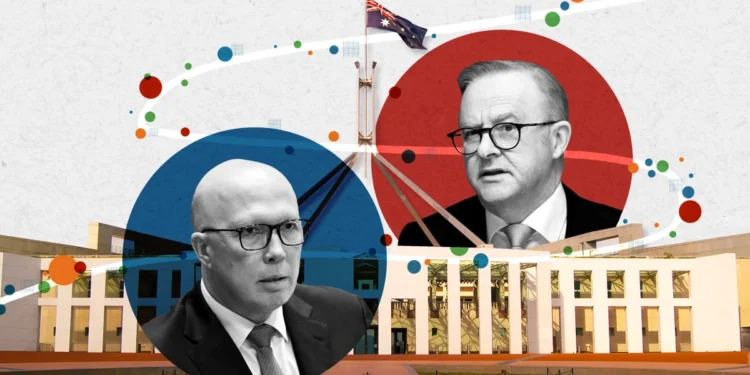How the Polls Reflect the Political Landscape Ahead of the Federal Election
As Australia moves closer to the 2025 federal election, opinion polls provide critical insights into voter sentiment, party standings, and potential election outcomes. With the contest between Labor and the Coalition intensifying, tracking polling trends helps gauge public opinion and understand the factors shaping electoral preferences.
Averaging data from multiple polls offers a more reliable picture of voter behaviour, smoothing out inconsistencies that may arise from individual survey methods. This analysis delves into the latest polling trends, the two-party preferred vote, demographic insights, and the broader shifts in Australian politics as voters prepare to head to the polls.
The Poll Averaging Model and Its Importance
Interpreting opinion polls requires more than just looking at individual surveys. A poll averaging model, such as the one developed by political experts at the University of Sydney, enhances accuracy by aggregating data from multiple sources.
This model accounts for variations in sample size, previous polling accuracy, and potential biases from different pollsters. By using a weighted approach, the analysis minimises statistical noise and highlights underlying trends. The inclusion of credibility intervals also reflects the uncertainty inherent in polling, ensuring that shifts in voter sentiment are not overstated.
Given the volatility of political preferences, relying on an averaged perspective rather than isolated polls provides a clearer understanding of where each party stands. The results not only inform political strategies but also help voters navigate the evolving landscape of electoral competition.
Two-Party Preferred Vote: Labor vs Coalition
One of the key indicators in Australian election polling is the two-party preferred (2PP) vote, which compares the projected vote share between Labor and the Coalition after preferences are distributed.
Since the 2022 federal election, the 2PP vote has seen notable fluctuations, reflecting shifts in public sentiment due to economic concerns, policy debates, and leadership performance. At present, polling averages suggest a closely contested race, with neither party securing a dominant lead.
Historically, elections have been won or lost based on marginal movements in 2PP polling. While a narrow lead can indicate momentum, the final result depends on individual electorate dynamics and how minor parties and independents influence preference flows. With voter volatility increasing, even small shifts in polling numbers could have significant electoral consequences.
Primary Vote Trends: Declining Support for Major Parties
Beyond the 2PP vote, the primary vote share of each party offers crucial insights into their electoral strength. Over the past few decades, the dominance of the two major parties—Labor and the Coalition—has eroded, with a growing number of voters shifting towards independents and minor parties.
Comparing historical data since 1951 reveals a steady decline in primary vote support for both major parties. Previously, a primary vote share exceeding 40% was a strong indicator of electoral success. However, in recent elections, neither Labor nor the Coalition has consistently maintained such levels.
This decline reflects broader changes in Australian political engagement. The rise of issue-based politics, increasing distrust in major parties, and the influence of high-profile independents have reshaped voting patterns. The 2025 election is likely to continue this trend, making preference distributions more critical in determining the final outcome.

How Demographics Shape Voting Preferences
Polling data provides valuable insights into how different demographic groups influence electoral outcomes. Understanding these trends helps explain shifts in party support and potential voting behaviour.
Age-Based Voting Patterns
Age continues to be a defining factor in political alignment. Younger voters, particularly those under 35, have increasingly supported progressive policies, leading to stronger backing for Labor and the Greens. In contrast, older Australians, especially those over 55, tend to lean towards the Coalition, favouring economic stability and traditional policy approaches.
This generational divide has been evident in recent elections and is likely to persist in 2025. However, voter turnout among younger demographics has historically been lower, which could impact the effectiveness of Labor’s appeal to younger Australians.
Education Levels and Political Preferences
Education is another significant determinant of voter behaviour. Polling data indicates that university-educated voters are more likely to support Labor and the Greens, particularly on social and environmental issues. Conversely, those with TAFE or technical education backgrounds display a more mixed voting pattern, often influenced by economic and employment concerns.
Voters without tertiary education have shown stronger support for the Coalition, with economic management being a primary consideration. These distinctions highlight how policy priorities differ based on educational background, shaping how parties craft their campaign messages.
Gender and Voting Intentions
Gender disparities in political support have become more pronounced in recent elections. Women have increasingly leaned towards progressive parties, citing issues such as workplace equality, childcare, and healthcare. Labor and the Greens have benefitted from this trend, particularly among younger and middle-aged female voters.
Men, on the other hand, remain more evenly split between Labor and the Coalition, with economic policies and national security often being key decision-making factors. These gender-based voting preferences could influence campaign strategies, particularly in marginal seats where small swings can determine the overall result.
State-by-State Breakdown
Voting patterns vary significantly across different states, reflecting local economic conditions, policy priorities, and historical political leanings.
- New South Wales and Victoria remain key battlegrounds, with Labor holding a stronger presence in metropolitan areas while the Coalition maintains regional support.
- Queensland has traditionally favoured the Coalition, although recent by-elections suggest a potential swing in specific electorates.
- Western Australia has emerged as an electoral wildcard, with shifting voter sentiment playing a crucial role in federal elections.
- South Australia and Tasmania often witness close contests, making preference flows and minor party influence more significant.
Polling data for smaller states tends to be less frequent, but historical trends provide a general guide to expected voter behaviour.
Compilation of Recent Polls and Key Insights
To understand the latest polling landscape, examining a compilation of recent surveys provides a snapshot of voter sentiment. Polling firms such as Essential, Newspoll, and Resolve Strategic offer varied insights, but when aggregated, they present a more balanced view of political trends.
Key insights from recent polls include:
- Labor and the Coalition remain in a tight race, with slight variations depending on the polling firm.
- Support for minor parties and independents is growing, highlighting voter dissatisfaction with traditional party choices.
- Economic management and cost of living remain the most influential issues, shaping voter priorities ahead of the election.
- Leadership approval ratings continue to fluctuate, with both major party leaders experiencing shifts in public perception.
By tracking these polls over time, patterns emerge that indicate which issues resonate most with voters and how party strategies may evolve in response.
Understanding the Polling Methodology
Polling accuracy depends on the methodology used to collect and interpret data. The model applied to these polls incorporates rolling averages, ensuring that outlier results do not disproportionately impact overall trends.
One challenge in demographic polling is the inconsistency in data availability. While broad voting trends can be established, variations in sample sizes for specific groups mean that rolling averages are often used to smooth fluctuations.
The credibility interval—a measure of statistical uncertainty—further helps contextualise polling results. Instead of treating individual polls as definitive, the approach acknowledges potential variances and provides a more realistic range of voter support levels.
The Evolving Political Landscape
As the 2025 Australian federal election draws closer, polling trends will continue to fluctuate based on policy announcements, economic shifts, and leadership debates. The growing influence of minor parties and independents underscores a changing political environment where voter loyalty is no longer guaranteed.
With the electorate more unpredictable than ever, the final outcome will depend on preference flows, marginal seat battles, and voter turnout rates. Polling data provides a valuable tool for understanding these dynamics, but the true test will come on election day when Australians cast their votes.











